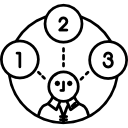Procedural thinking

Wing (2006, 2011) defined computational thinking as the thought processes involved in formulating problems and their solutions so that the solutions are represented in a form that can be effectively carried out by a computer. [2]
Computational Thinking (CT) is a process that generalizes a solution to open-ended problems. Open-ended problems encourage full, meaningful answers based on multiple variables, which require using decomposition, data representation, generalization, modeling, and algorithms found in Computational Thinking. Computational Thinking requires the decomposition of the entire decision making process, the variables involved, and all possible solutions, ensuring that the right decision is made based on the corresponding parameters and limitations of the problem. The term computational thinking was first used by Seymour Papert in 1980 and again in 1996. Computational thinking can be used to algorithmically solve complicated problems of scale, and is often used to realize large improvements in efficiency[3]
- This includes identifying the steps and putting them in the correct order. Such as recipes, block-arrow-block-arrow
- Constructing procedures that can then be referred to by their identifier.
Standards[edit]
- Identify the procedure appropriate to solving a problem.
- Evaluate whether the order in which activities are undertaken will result in the required outcome.
- Explain the role of sub-procedures in solving a problem.